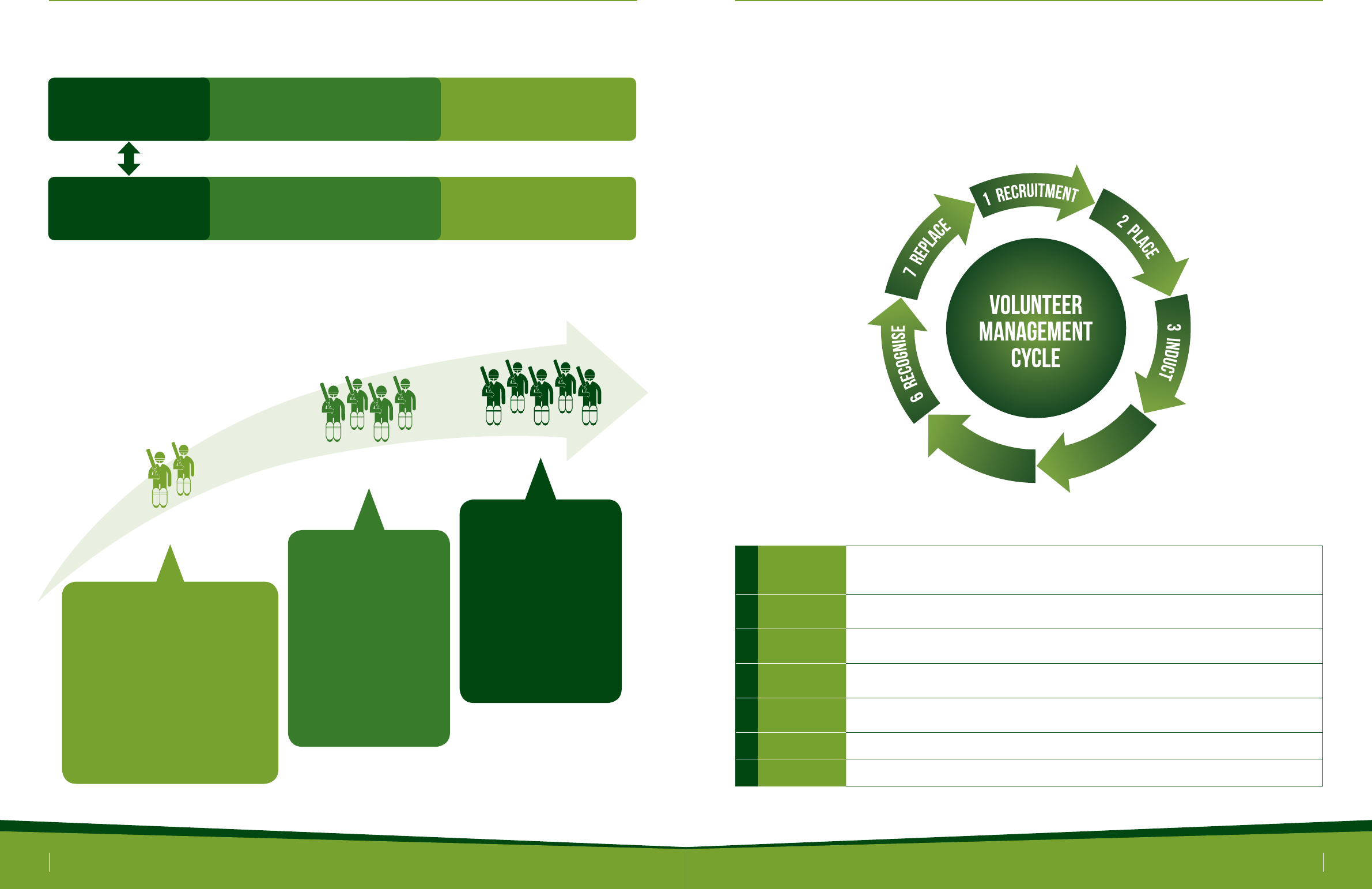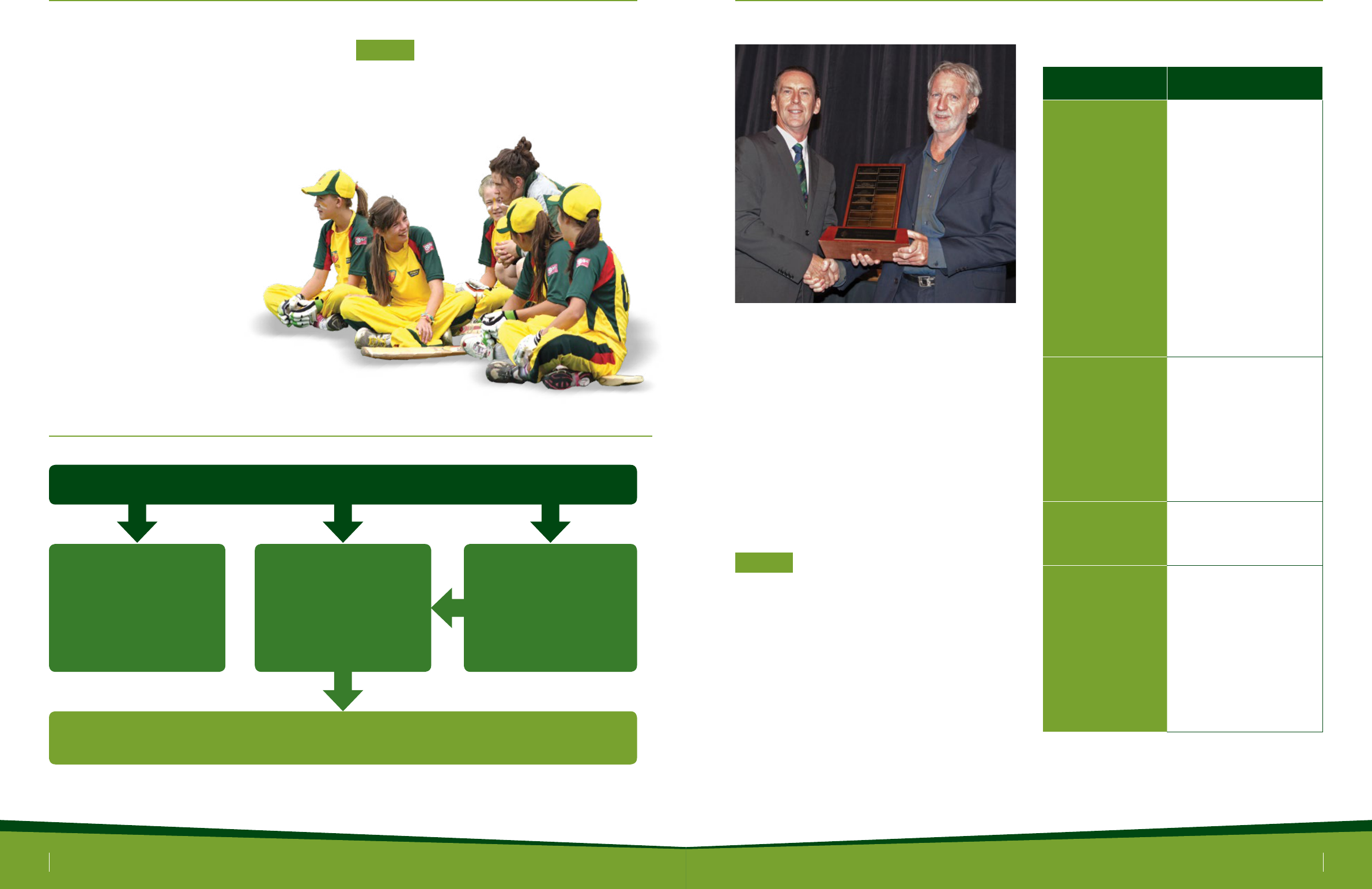
Volunteer
Management
Framework
CRICKET AUSTRALIA

VOLUNTEER MANAGEMENT FRAMEWORK
1

Disclaimer
Contents
Cricket Australia RECOGNISE'S THAT volunteers are the life-blood OF
A CLUB OR ASSOCIATION and are essential in ENSURING cricket is fun,
competitive, socialand safe.
Like most sports, there is a high
turnover of volunteers, with
recruitment and retention activities
representing an ongoing demand
on resources.
Though advances in technology
are improving the collection and
dissemination of information to
volunteers, volunteering remains a
‘people-based,, face-to-face game’.
VOLUNTEERS ARE INCREASINGLY
BECOMING MORE PREPARED TO
COMMIT TO A WELL-ORGANISED AND
PROFESSIONAL ORGANISATION FOR
A SPECIFIC TASK AND/OR A FINITE
PERIOD. TO THIS END, CRICKET
AUSTRALIA HAS DEVELOPED A
VOLUNTEER MANAGEMENT FRAMEWORK
TO ASSIST AFFILIATED ASSOCIATIONS
AND CLUBS ENHANCEA VOLUNTEER’S
EXPERIENCE AND TO DEVELOP THE
EXPERTISE OF VOLUNTEERS.
It is acknowledged that a number
of strategies and initiatives are
already undertaken by Cricket
Australia, other State and Territory
Cricket Associations, affiliated
Associations and Clubs to recruit
and retain volunteers.
The Volunteer Management
Framework is a holistic approach
to volunteering which is applicable
across all levels of cricket in Australia
i.e.: State-Associations-Clubs.
Each level of cricket can utilise
theplan to;
» review existing activities,
» assess the gaps, and
» introduce new activities.
Over the past decade, statistics
indicate that trends in volunteering
have significantly changed. Families,
and people in general, lead such
busy lives that the time to commit
and take part in volunteering at the
local cricket Club or Association is
becoming increasingly harder.
One of the targets for cricket in
Australia is to increase participation
substantially and inspire Australia’s
next generation of players, fans
and volunteers. In Australia, we are
experiencing a steady increase of
junior participation through our
junior Clubs. It is crucial that the
experience young boys and girls
are having on their cricket journey
at a young age continues until they
reach senior cricket. Our Clubs
need to be well organised and be
efficiently run with a strong base
of volunteers. Clubs must prioritise
how they manage volunteers to
ensure longevity of cricket at a
community level.
Introduction
INTRODUCTION 3
Volunteer Management Framework 4
Volunteer Management Plan 5
1 Recruitment 6
2 PLACE 10
3 INDUCT 13
4 TRAIN 13
5 SUPERVISE 15
6 RECOGNISE 17
7 REPLACE 18
CONTACTS INSIDE BACK COVER
Acknowledgements
The National Volunteer Management Framework
has been developed using the Western Australian
Cricket Association (WACA) Volunteer Management
Framework as a guide. Cricket Australia, in partnership
with the WACA, have adapted the WACA model to be
suitable for adoption on a national scale.
Special thanks is extended to the WACA, in particular
AlanSinger, and the broader WACA Game and Market
Development team for researching, coordinating and
preparing the Volunteer Management Framework, with
support from Cricket Australia staff.
This document is published by Cricket Australia to provide general information
only. Although every effort is made to ensure that information in this document
is accurate, Cricket Australia is not responsible for the continued accuracy of the
information, the application of that information or for any errors, omissions or
inaccuracies in any information contained in this document. The publication of
information in this document does not constitute a representation or warranty
either express or implied, that the information has been approved or tested
by Cricket Australia or that it is suitable for general or particular use. Readers
should exercise their own skill and care with respect to its use. Before relying on
any information contained in this document, readers should carefully evaluate
the accuracy, completeness, appropriateness and relevance of the information,
and should obtain appropriate professional advice relevant to their particular
circumstances.
Key contributors
» Tamara Mason
» Grant Poulter
» Andrew Ingleton
» Mark Simpson
» Paul Milo
» Belinda Clark
» Matthew Betsey
» Andrew Caldwell
» Sonya Thompson
» Cameron French
» Sinead O’Hara
» John Watkin
» Tavis Vallance
» William Rice
» Marita Forss
» Emily Cross
VOLUNTEER MANAGEMENT FRAMEWORK VOLUNTEER MANAGEMENT FRAMEWORK
2 3

The Volunteer Management Framework incorporates:
Cricket Australia understands that all Clubs are unique and that the number of volunteers differ from Club to
Club. TheVolunteer Management Framework has been developed to assist Clubs with managing their volunteers.
Notevery Club will be in a position to utilise every action point throughout the framework, however Clubs are
encouraged to begin tophase action items into their day-to-day volunteer operations.
VOLUNTEER MANAGEMENT FRAMEWORK
Figure 1
Volunteer
Management
Easy Wins
VOLUNTEER
MANAGEMENT PLAN
Articulates all aspects of
recruiting and retaining
volunteers in AUSTRALIAN CRICKET
Volunteer Coordinators
and Community Cricket
Clubs responsibility
VOLUNTEER MANAGEMENT
ACTION PLAN
Lists the outstanding work to be
completed to fulfil the Volunteer
Management Plan
STATE SPORTING ASSOCIATIONS
to work alongside Community
Cricket Clubs
The Volunteer Management Plan has two core functions:
1. Recruiting volunteers
2. Retaining volunteers
Both functions are continuous and must work in conjunction with each other to be most effective.
The success of the plan is dependent on the motivation of each level of cricket wanting to improve
a volunteer’s experience in cricket. If there is little or no motivation, then we shouldn’t expect
volunteers to reciprocate the same motivation.
VOLUNTEER MANAGEMENT PLAN
5
S
U
P
E
R
V
I
S
E
4
T
R
A
I
N
The Seven Cycles of Volunteer Management
1 Recruitment
Recruiting the right people into the right roles at your Club or Association is vital. This can
include identifying tasks and roles, the time and number of volunteers required, who does
the task and role now, and when will it finish.
2 Place
The process of promoting the tasks to be completed, attracting volunteers to do the tasks,
screening a volunteer’s suitability to perform the task, selecting and appointing volunteers to roles.
3 Induct
The process of welcoming volunteers to the Club or Association, informing volunteers of Club
or Association policies and procedures, and establishing preferred communication methods.
4 Train
Educating volunteers on specific information for the role, and additional learning and
development opportunities to enhance knowledge and skills.
5 Supervise
The process of monitoring and providing feedback to the volunteer on performance in
achieving the tasks.
6 Recognise
The process of acknowledging a volunteer’s contribution.
7 Replace
The process of filling vacated positions and the importance of succession planning.
Large Club
Multiple teams
Juniors AND Seniors
» Appoint a Volunteer
Coordinator to
the Committee
» Provide an opportunity
for volunteers to take
part in an exit interview
as they leave the
volunteering role
Medium Club
Juniors and Seniors
» Start to adopt
policies for the Club
» Ensure new volunteers
are inducted into the
Club appropriately
» Encourage coach and
entry level coordinator
training offered by the
State and Territory
Cricket Associations
Figure 2
Volunteer
Management
Cycle
Small Club
1-2 Teams
• Develop role descriptions for
each volunteer
• Add volunteers to each Committee
meeting as an agenda item
• Keep an up-to-date register of
all volunteers including contact
details, Working with Children
checks (WWCC) and/or other
licences and accreditations
VOLUNTEER MANAGEMENT FRAMEWORK VOLUNTEER MANAGEMENT FRAMEWORK
4 5

Position descriptions should outline
1.1 VOLUNTEER COORDINATOR
ACTION
It is recommended that each affiliated
Association or Club’s management Committee
appoint a Volunteer Coordinatorto implement
the VolunteerManagement Plan.
Most Associations and Clubs appoint people to key
positions, such as President, Treasurer or Secretary,
who provide direction and manage the administration
of the Club and Association. Very few have considered
or reviewed the way they manage their greatest
resource: volunteers.
The Volunteer Coordinator is committed specifically to
seeking new volunteers, assisting volunteers to perform
their role and promoting further opportunities to
develop volunteers. While this role may not be possible
in all Clubs and Associations, the importance of a
designated person to oversee the operations of a Club’s
volunteers is crucial to the running of the Club.
The management Committee will seek and identify
anappropriate person for the role.
1.2 VOLUNTEER PLACEMENTS
ACTION
The Volunteer Coordinator will establish
the affiliated Association or Club’s volunteer
roles. This is a list of each volunteer role,
the volunteering period and possible
volunteers tofill the role.
It is an essential planning tool which answers
key questions in attracting volunteers and
succession planning.
Questions
» What jobs need to get done?
» Who is doing them now?
» How long has the volunteer made a
commitment for?
» Who can fill the role if it is suddenly vacated?
» Who could possibly do the role in the future?
It is a similar process to identifying talented players
andplanning their development pathway.
Placements
Volunteering occurs through three different processes:
1. Set-term volunteer placements
2. Ongoing volunteer placements
3. One-time volunteer opportunities
Set-term volunteer placement
Set-term volunteer placements have a specified
time set for the role before it becomes automatically
vacant and available for another volunteer to do,
or for the incumbent to reapply. These positions
may be elected, (Committee or officer), appointed
or self-appointed (management Committees, Club
officers, representative and advisory Committees,
coaches,umpires, team managers and scorers).
Ongoing volunteer placement
Ongoing volunteer placements are based on the
incumbent's decision to continue in a role together with
satisfactory performance. This work is ongoing and
continuous throughout the year. These positions are
usually appointed such as Volunteer Coordinators, Bar
Managers, Canteen Managers and Statisticians.
One-time volunteer opportunities
One-time volunteer opportunities are casual
placements for a one-off event or activity such as
araffle or BBQ.
1 RECRUITMENT
1.3 POSITION DESCRIPTIONS
ACTION
The Volunteer Coordinator, in conjunction
withthe incumbent volunteer, will write
position descriptions for each volunteer role.
Template cricket volunteer job descriptions can
be found on the Club section of the MyCricket
Community Cricket website; a one stop shop
for all of your Club Cricket needs online:
community.cricket.com.au/clubs/running-
your-club/volunteers/volunteer-job-
descriptions
Most volunteer roles are listed in constitutions or by-
laws, however, additional information is required to
assist volunteers.
A simple and easy-to-read position description allows
prospective volunteers to match their skills, experience,
interests and time to a role before committing to it.
Likewise, it allows volunteers to be identified and
matched to roles.
PRESIDENT
VICE PRESIDENT
TREASURER
VOLUNTEER
COORDINATOR
REGISTRAR
COACH
CONVENER
UMPIRE
CONVENER
SECRETARY
GENERAL
COMMITTEE
MEMBER
GENERAL
COMMITTEE
MEMBER
UNIFORM
CONVENER
EQUIPMENT
OFFICER
WEBSITE &
NEWSLETTER
FUNRAISING
AND EVENTS
GENERAL
COMMITTEE
MEMBER
Figure 3
EXAMPLE Club Cricket Committee
Organisational chart
ACTION
The Volunteer Coordinator will maintainand
promoteanup-to-date organisational chart.
All position descriptions and an organisational chart
should be easily accessible e.g.: on the affiliated
Association or Club’s website or notice board.
Appointing a Volunteer Coordinator, writing the
position into your constitution and displaying it in your
Committee structure (see image below as an example),
is a great way to publicly advertise your commitment to
the volunteers you engage. This will also ensure there
is continual and consistent commitment to volunteer
management by your Association or Club.
» Member Screening Requirements such as
reference checks
» Criminal Record Checks and Working with
Children Checks (or equivalent requirements)
» Duties to be performed
» Time commitment
» Pre-requisites for the role:
» Skills and experience
» Licenses, qualifications or accreditations
» Codes of Behaviour/Codes of Conduct
» Supervisory and reporting requirements
» Out-of-pocket expenses policy
VOLUNTEER MANAGEMENT FRAMEWORK VOLUNTEER MANAGEMENT FRAMEWORK
6 7

How the Volunteer Coordinator fits within a Club's
and Association's Committee structures may vary
depending on your size, number of volunteers and the
degree of importance that you place on managing
volunteers. Smaller Clubs and Associations may find it
more suitable for the Volunteer Coordinator role to be
incorporated into an already existing role
(e.g. Vice President or Secretary).
The Volunteer Coordinator acts as the link between
the management Committee and the volunteers
themselves. TheVolunteer Coordinator does not
necessarily supervise or manage the volunteers, but
manages the volunteer plan and volunteer policies.
Position Description
Volunteer Coordinator
As with any position (paid or unpaid), a position
description for the role of Volunteer Coordinator is vital.
The following is an example of a position description.
ACTION
The Volunteer Coordinator will
receivetheirown jobdescription.
Ensure that the subject of volunteers is carried over
at each Club and Association meeting on the agenda.
If it’s not on the agenda, it increases the likelihood of
not being spoken about. Encourage your Committee
to start talking about the topic of volunteers in a
structured approach.
Below is a list of position descriptions for standard
volunteer roles within Australian Cricket Associations
and Clubs. Position descriptions can be located at
community.cricket.com.au/clubs/volunteers/volunteer-
job-descriptions
1.4 CONDUCT ANNUAL REVIEW
ACTION
An annual review will be conducted by
theVolunteer Coordinator before season's
end,inpreparation for next season.
The Annual Review will:
a. Review all volunteer position descriptions with
theincumbent volunteer to ensure the description
complies with legislation, Club or Association
policies andaccurately reflects the role.
b. Set dates for next season’s inductions,
interviewsand training courses/workshops.
c. Re-quantify volunteer roles.
d. Identify individual volunteer training and
development opportunities.
e. Determine recruiting strategies and
coordinateaseason review.
f. Determine whether any volunteers require an
update of their Working with Children and/or
Police Check and any other annual requirements.
1.5 OUT-OF-POCKET EXPENSES
ACTION
The affiliated Association or Club must review
annually its guidelines on reimbursingout-of-
pocket expenses.
Expenses might include such items as fuel to attend
meetings or matches, telephone calls or printing.
Questions
» What is considered ‘extraordinary’ out-of-
pocketexpenses?
» Is there a financial cap for an expense?
(e.g. Club will pay a coach’s phone bill capped
at$20a month)
» What is the process and requirements to claim
out-of-pocket expenses? (e.g. receipts required,
logbooks, claim must be made within 30 days)
» Who can approve the expense claim?
(e.g. Treasurer, management Committee)
1.6 INSURANCE
ACTION
The affiliated Association or Club will provide
appropriate insurance cover for volunteers.
The policy schedule will be reviewed annually.
Information regarding legal responsibilities, and
insurance cover and claims, should be made available
tovolunteers as part of the induction process.
1.7 COMMUNICATION
ACTION
The Volunteer Coordinator will ensure each
volunteer is meaningfully communicated
withat least once a month on their role.
Though technology enhances the dissemination
andincreases access to information, the key strategy is
to educate volunteers where to find the information.
The importance of cyber safety within Clubs and having
a policy so that all members and Volunteer Coordinators
know what is appropriate behaviour is crucial.
Communication preferences should be to:
1. Person-to-person (phone or meeting)
or group meeting
2. Email
3. Club website and MyCricket
4. Newsletter
5. Social media including Facebook
For more information on how to develop a social
mediapolicy and learn more about this topic,
pleasevisit the following link:
playbytherules.net.au/toolkits/social-media-toolkit
For more information on cyber safety
and cyber bullying, please visit:
esafety.gov.au/esafety-information/esafety-issues
1.8
A SPORT FOR ALL:
DIVERSITY & INCLUSION
Cricket is an inclusive sport that celebrates the diversity
of its participants regardless of gender, ethnicity, age
and religious beliefs. As a leading global sport, cricket
captivates and inspires people of every age, gender,
cultural background and ability, while building bridges
between continents, countries and communities.
Australian cricket has continued to improve its access to
a wide-range of non-traditional participants, including
women, Indigenous communities, people of non-English
speaking backgrounds and people with disabilities.
To find out ways in which your Club or Association
canbecome more inclusive of its surrounding
communities and start recruiting new members to
assist, grow and maintain your Club or Association,
please visit the following link and check out the
ASportfor All training and resources:
community.cricket.com.au/clubs/running-your-club/
a-sport-for-all
For any further information or assistance in becoming
a more inclusive environment for members and new
volunteers, please contact your State or Territory
Cricket Association and ask to speak to a staff
member from the Game and Market Development
orCommunity Engagement Team.
Figure 4 Example Club Role Descriptions
1 RECRUITMENT
PRESIDENT
SECRETARY
SAFETY
COORDINATOR
VOLUNTEER
COORDINATOR
TREASURER
COACH
TEAM
MaNAGER
MA
TCHDAY
coordinator
UMPIRE
Cricket Blast
COORDINATOR
VOLUNTEER MANAGEMENT FRAMEWORK VOLUNTEER MANAGEMENT FRAMEWORK
8 9

2.1 ATTRACT
ACTION
As part of the annual review, the Volunteer Coordinator in conjunction with the
Committeemembers, will determine recruitment strategies to be implemented.
This includes, but is not limited to the following:
» Advertising internally through
existing communication channels.
» Identifying and personally
approaching individuals.
» Conducting information
workshops about roles.
» Establishing rosters.
» Externally advertising e.g. Seek
Whilst affiliated Associations or Clubs
may request an obligation to volunteer
as part of its membership conditions,
they should not coerce anybody
to volunteer.
It is recommended that junior Clubs
establish a match day volunteering roster
of parents to ensure work is evenly spread
among all rather than a few. Senior Clubs
should do the same with players. Rosters
should be determined and committed to at
the time of member registration.
The affiliated Association or Club should
provide comprehensive information about
each volunteer role on its website. This should
include position description for each role and
induction information.
If there is difficulty in identifying and placing
volunteers into roles, consideration needs to be
given to modifying the roles such as:
» Less elected, and more
appointed, volunteer roles.
» Breaking the role up into
smaller manageable tasks.
» Entrusting and delegating responsibility
to allow volunteers to get on with the job.
» Longer terms (3 years
rather than annually).
» Role sharing.
» Overlapping terms.
2 PLACE
2.2 SCREEN
See Club Support Program for State and Territory
specific legislation for working with children:
community.cricket.com.au/clubs/running-your-club/
club-support-program.
Volunteers will be assessed against the position
description and placed in activities that suit their
skills, interests, knowledge and experience. If a
volunteer is exempt from a Working With Children
Check (WWCC), consideration should be given to
the Volunteer National Police certificate and National
Police Certificate. Volunteers and paid staff should go
througha screening process such as reference checks
to ensure they are appropriate for the position they are
apply for.
Working with Children
Each State and Territory has its own legislative
requirements, which can be found below.
State and Territory Cricket Associations requires
Regions and Associations to ensure that their Clubs
and individual affiliates, including volunteers who are
involved with working with children (under 18), have
a current WWCC or National Police Check (where
exempt from WWCC or equivalent).
ACTION
Volunteers will meet with the respective
supervisor before commencing their role.
A standard interview checklist will be
providedoutlining a suggested meeting
formatandcore questions.
Steps to Screening
Remember, a WWCC, National Police Certificate
or Volunteer National Police Certificate does not
guarantee someone’s suitability to work inaClub or
Association. Responsible Clubs and Associationsneed
to use a number of risk management strategies to
ensure the selection of only the most appropriate
and suitable volunteers. Clubs and Associations are
encouraged to keep an up-to-date register of all
of its volunteers and currentWWCC/Police Check
information. In some States and Territories, this is a
legislative requirement.
Thefollowing steps illustrate a best practice model:
APPLICATION FORMS
CONDUCT INTERVIEWS
CONDUCT REFERENCE CHECKS
CRIMINAL RECORD CHECKS/WWCC
SIGNED AGREEMENTS
DETERMINE THE RISK OF THE VOLUNTEER POSITION
DEVELOP POSITION DESCRIPTION
Working with Children (OR EQUIVALENT) Links
ACT accesscanberra.act.gov.au/app/answers/detail/a_id/1804/session
NSW kidsguardian.nsw.gov. au/working-with-children/working-with-children-check
NT nt.gov.a u/emergency/community-safety/apply-for-a-working-with-children-clearance
QLD bluecard.qld.gov.au
SA police.sa.gov. au/services-and-events/apply-for-a-police-record-check
TAS justice.tas.gov.au/working_with_children
VIC workingwithchildren.vic.gov.au
WA workingwithchildren.wa.gov.au
VOLUNTEER MANAGEMENT FRAMEWORK VOLUNTEER MANAGEMENT FRAMEWORK
10 11

2.3 SELECT
A constant challenge in Clubs and Associations is the
limited choice when it comes to selecting volunteers.
Volunteer Coordinators may also find it a challenge
as volunteers are sometimes elected to positions,
particularly at Committee level. As a result, they may
not have the necessary skills or abilities to fulfil a
particular role, which sometimes is not clearly defined
in the first place. In other situations, a volunteer might
be recruited because a Club or Association needs an
extra “pair of hands” and not because of their particular
skills or abilities. These circumstances are difficult to
control and are often exacerbated by an under-supply
of volunteers. Despite these hurdles, it is important that
a selection and screening policy is in place to ensure
the volunteer is suitable for the role they fulfil.
The Club or Association has the right to refuse a
volunteer’s offer of service if:
» the volunteer's criminal record check/WWCC
returns a result that does not allow them to work
with children or raises concerns;
» there is a perceived or actual risk to the Club or
Association, or the volunteer’s health or welfare;
» the volunteer is not suited to the task or duties to
beundertaken;
» the desired duties or location are not available;
» the volunteer will not be covered by Club or
Association's insurance; or
» the volunteer does not comply with any reasonable
request for personal information (e.g. name, address,
personal and emergency contact details, and
police clearance).
ACTION
Appointments will be formally recognised by
a standard or personalised Welcome Letter.
Reference Check
Depending upon the position, it may be useful to
followup on a reference. Through identifying the
level of trust required of a position and asking specific
questions of the referees, the applicant’s suitability
maybe easier to determine.
Cricket Australia recommends reference checks for
positions including coaching, umpiring, and Committee
members. For more information on volunteer
management, please visit community.cricket.com.au/
clubs/volunteers/volunteer-management
These are all available for Clubs and Associations to
follow when inducting new volunteers into the Club
or Association and to be encouraged to distribute
amongst the Club's members.
ACTION
The Volunteer Coordinator or Committee
member will add volunteer roles and all other
Committee roles onto MyCricket prior to the
commencement of the season and conduct
regular maintenance over the course of a
cricket season.
ACTION
Upon election or appointment, volunteers
will be inducted into the affiliated Association
or Club’s policies, guidelines and safety
requirements prior to commencing the role.
Set-term and ongoing placed volunteers should
receiveaWelcome Letter and induction pack.
One-time or casual placement volunteers should
beprovided an induction briefing on the tasks to
becompleted.
The Volunteer Coordinator should use the induction
checklist as a guide to ensure the volunteer;
» is familiar with the Club or Association's objects
» understands their role
» understands lines of responsibility and supervision
» is aware of their rights and responsibilities
» feels welcome
» is aware of the Club and Association’s facilities
» receives a copy of all relevant policies
andprocedures
» understands occupational health and safety issues
» has met the relevant Committee members
orcoaches, and
» understands the Club's history.
A name badge
and shirt may be provided to clearly
identify volunteers.
For more information on volunteering, please visit
community.cricket.com.au/clubs/running-your-
club/volunteers
ACTION
As part of the annual review, the Volunteer
Coordinator will seek, plan and offer training
and development opportunities forvolunteers.
This will require the following:
» Understanding the current skills and qualifications
ofvolunteers
» Consulting with volunteers about their perceived
training needs.
» Identifying and informing volunteers of training
anddevelopment opportunities.
» Promoting an annual calendar of training and
development opportunities.
» Identifying training opportunities appropriate to
specific roles, such as meeting procedures for
meeting chairperson or financial management
processes for Treasurers.
All volunteer training and development opportunities
should be promoted through the affiliated Association
or Club’s normal communication channels.
All volunteers should undertake training specific to the
role as detailed in the position description.
Well-trained volunteers will feel more capable and
confident, increasing their volunteer experience. This in
turn will have a positive influence on volunteer retention.
In saying this, it is always important to consider flexible
training options to suit the needs of the busy volunteer.
In some cases, attending a training course, while
preferable, might not be feasible. A workable solution
however, may be to refer the volunteer to a publication
or website that provides relevant and up-to-date
information on the subject matter.
While cost is often seen as a barrier to providing
training opportunities to volunteers, it should be
perceived as an investment.
The Volunteer Coordinator is not usually responsible
for designing and delivering training and development
programs for volunteers. Their role is to do the following:
» Search for and gather information about
training opportunities.
» Keep a record of the skills, qualifications and training
courses attended by volunteers, or gained before or
during their time with the Club or Association.
» Regularly update the volunteer database with
volunteer qualifications, skills and experience.
» Consult with volunteers about their training needs.
» Evaluate the cost, effectiveness and relevance of
training programs and activities.
3 INDUCT 4 TRAIN2 PLACE
VOLUNTEER MANAGEMENT FRAMEWORK VOLUNTEER MANAGEMENT FRAMEWORK
12 13

Training Opportunities
State AND TERRITORY Associations
State and Territory Cricket Associations offer a
number of training courses aimed at ensuring umpires,
coaches, parents and all cricket administrators, at
all levels, receive intensive practical instruction in
the latest MyCricket information, rules and coaching
methods. Please visit your local State or Territory
Cricket Association website for upcoming training
opportunities, or make contact withyour local
Regional Cricket Manager to find out what’s coming
up in your local area.
VOLUNTEERING Australia
It is important for a Club or Association to provide
opportunities for volunteers to gain skills that are
necessary for their position. It is also important to
up-skill volunteers with training and development.
Volunteering Australia provides online training to
volunteers including certificates in active volunteering.
Contact: Volunteering Australia
Telephone: (02) 6251 4060
Email: marketing@volunteeringaustralia.org
Website: www.volunteeringaustralia.org
FIRST AID
First aid training can be organised through
St John Ambulance.
Contact: St John Ambulance
Telephone: 1300 360 455
Email: [email protected]
Website: http://stjohn.org.au/
Play by the Rules
Play by the Rules provides information on how to
prevent and deal with inappropriate behaviour.
This includes child protection, complaint handling,
discrimination, harassment, favouritism, bias and
various forms of abuse.
Play by the Rules offers free online training courses
for coaches, administrators, umpires and referees,
participants, volunteer, and Member Protection
Information Officers. The courses are short
(taking no more than two hours), may be done in part
or all at once, and make extensive use of case studies.
Cricket Australia highly recommends that the
Volunteer Coordinator undertakes the online training.
Website: www.playbytherules.net.au
our community
Our Community is an Australian organisation
whose aim is to build stronger communities
through strengthening community agencies.
Their comprehensive website has a number of
free online resources, articles and fact sheets of
relevance to volunteer training in a broad range of
areas including; IT, risk management, community
leadership, fundraising, boards of management and
themanagement of volunteers.
Contact: Our Community Pty Ltd
Telephone: (03) 9320 6800
Email: service@ourcommunity.com.au
Website: ourcommunity.com.au
A SPORT FOR ALL
Australian Cricket offers free inclusion and diversity
training for community administrators and volunteers
designed to increase participation amongst our
diverse communities.
Email:
Website:
co mmunity.cricket.com.au/clubs/
running-your-club/a-sport-for-all
The management Committee is accountable to
members who elected them to the position.
Other volunteers will operate under the direction of a
supervisor. This will be stated in the position description
or induction.
Supervision includes:
» Planning work to be achieved and providing
feedback on performance.
» Communicating logistical requirements for the work.
» Providing guidance so the volunteer achieves the
planned tasks effectively and efficiently.
» Ensuring records (time sheets, logs) are completed.
» Maintaining a safe environment.
To be more effective with volunteers, the Club
or Association should establish a supervisor-to-
volunteer ratio of no more than 1:9. (i.e. 1 supervisor to
9volunteers).
5.1 EVALUATION/FEEDBACK
The supervisor will offer on-going, regular and
immediate volunteer feedback.
Volunteers are encouraged to provide ongoing feedback
to supervisors and any volunteers they supervise.
Supervisors are to provide immediate
feedbacktovolunteers;
» of their performance and addressing conflict, and
» recognising “burnout”, or when a volunteer is feeling
stressed (either from volunteering, or because of
personal matters, etc.)
The management Committee will assess their
performance annually as part of its Governance Policy.
5.2 ADDRESSING CONFLICT
For matters which cannot be resolved immediately,
please refer to the affiliated Associations or Club's
po
licies regarding member protection.
Member Protection
Information Officer (MPIO)
MPIOs are people trained to be the first point of
contact within your Region/Association (or Club)
for any persons considering making a complaint or
claim under the Member Protection Policy. MPIOs
provide confidential, impartial and timely support and
information. They also provide information about the
local complaint resolution options available to address
the individual's concerns. Cricket Australia recommends
that each Association has a qualified MPIO. State and
Territory Cricket Associations around the country have
a number of staff who have completed the Member
Protection Information Course and who are available to
assist Associations and Clubs, if required.
Please visit the Cricket Australia Community website
community.cricket.com.au for State and Territory
contact details of an MPIO.
For more information on how you can become a MPIO,
or any other information, please head to the Cricket
Australia Community website:
community.cricket.com.
au/clubs/running-your-club/well-played
Understanding
Complaint Handling
In the perfect world, there would never be any
complaints and we wouldn’t need to understand
anything about complaint handling. Unfortunately,
we don’t live in a perfect world. Things can go wrong
and people have a right to complain and have their
concerns listened to and dealt with. The below link
explains the differences between an MPIO and a
Complaint Handler.
playbytherules.net.au/news-centre/hot-topics/
1454-understanding-complaint-handling
Play by the Rules provides a Complaint Handling Course
to volunteers; the link for this course is below.
It is succinct, user-friendly and features case studies,
practical scenarios and incorporate the latest interactive
technology.
playbytherules.net.au/component/content/article/ 45-
online-learning/online-learning/1305-complaint-
handling-course
5 SUPERVISE
4 TRAIN
VOLUNTEER MANAGEMENT FRAMEWORK VOLUNTEER MANAGEMENT FRAMEWORK
14 15

5.3 REPORTING A DISCLOSURE OR SUSPICION
Child reports or you observe or suspect an incident of child abuse
THE DEPARTMENT FOR CHILD PROTECTION AND FAMILY SUPPORT WITHIN EACH
STATE/TERRITORY, AND POLICE WITH GIVE ADVICE ON THE NEXT STEPS
If you suspect a child is in
danger or for emergencies
contact emergency
services on 000
Report to the State/
Territory Department
of Child Protection and
Family support or the
Police as soon as possible
Report to appropriate
person at the club who
documents details of the
incident ensuring the
State Sporting Association
procedures are followed
Volunteers should be recognised informally and formally.
It is acknowledged that a number of strategies and
initiatives are already undertaken by Cricket Australia,
and the affiliated State and Territory Associations and
Clubs to recognise volunteers.
Some recognition initiatives already in place in the
Australian Cricket Community are
» State Volunteer Function e.g. WACA / VIC / NSW etc.
» Regional Volunteer and Club of the Year Awards
» Youth Volunteer of the Year (male and female)
» National Volunteer of the Year
» Long Service to Cricket Award
» National acknowledgment of small,
mediumandlarge cricket Clubs
ACTION
The Volunteer Coordinator will assess
anappropriate recognition strategy for
eachvolunteer, either by observation or
byasking them.
A list of recognition initiatives together with each
recipient’s name will be recorded.
The Volunteer Coordinator will continually review
recognition activities.
Each volunteer will be at least recognised annually
whenit is timely and due, and in line with expectations
and the volunteer’s personality.
Recognition may include:
STRATEGY RECOGNITION
Praise
» Offer small gifts, such
as sports vouchers
and iTunes vouchers
» Recognise/profile
in the newsletter
» Publically recognise in
a speech from a senior
member of the Club
» Send appreciation
letters and certificates
» Say ‘Thank You’
» You may wish to involve
your local member of
Parliament or Councillor
in acknowledgment
activities to amplify
the praise (this may
also result in local
media coverage).
Affiliation
» Invite to social events
» Free tickets to matches
» Send birthday card
» Provide name badge
and shirt
» Listing volunteers
in annual report
» Provide a reference
» Nomination for
external awards
Accomplishment
» Appreciation certificate
» Life membership
» Social function
» Media announcement
Power AND
Influence
» Appointment to a
supervisory role
» Attendance at
workshops and
conferences
» Professional
development
opportunities
» At-match on screen
recognition
» At-match functions
including lap of honour
As part of the annual review, the Volunteer Coordinator
will assess and recommend personal recognition
options and timing.
6 RECOGNISE5 SUPERVISE
CONTACT INFORMATION
For contact information for relevant State and Territory
Member Protection Information Officers (MPIO), please
refer to the numbers below:
Cricket ACT
02 6239 6002
Cricket NSW
02 8302 6000
Cricket Tasmania
02 6282 0400
Queensland Cricket
07 3292 3100
Cricket Victoria
03 9085 4000
Northern Territory Cricket
08 8944 8900
South Australian Cricket Association
08 8300 3800
Western Australian Cricket Association
08 9265 7222
Cricket Australia MyCricket Support Helpdesk
1800 CRICKET
VOLUNTEER MANAGEMENT FRAMEWORK VOLUNTEER MANAGEMENT FRAMEWORK
16 17
ACTION
Club and Associations allocate
or have an accredited Member
Protection Information Officer

7.1 Replacement of your Volunteers
Cricket Australia recognises there will be a turnover of volunteers for various reasons.
ACTION
As part of the annual review, the Volunteer
Coordinator will list each volunteer role,
the volunteering period and possible
volunteers tofill the role.
It is important that upon each volunteer is active in
advocating volunteer replacements by identifying
individuals, seeking their interest and inviting their
involvement. This process is ongoing.
Each management Committee will commit to
at least two agenda items per year to discuss
succession planning.
Volunteers leaving of their own accord will be formally
recognised by the Club or Association for their
contribution. The appropriate recognition will be
determined by the Volunteer Coordinator.
The affiliated Association or Club has the right to end a
placement for the following reasons:
» There is a perceived or actual risk to the
affiliated Associationor Club, the event, game or
volunteer’shealth or welfare.
» The member screening criminal record check is
notup-to-date, or has received a WWCC negative
notice or interim negative notice
» The volunteer is not suited to the task or duties to
beundertaken.
» The desired duties are not available.
» The event is being adversely affected by the
behaviour or performance of the volunteer.
» The volunteer does not comply with the affiliated
Association or Club’s policies, guidelines and
procedures or position description.
» The volunteer will not be covered by affiliated
Association or Club’s insurance.
In cases where a volunteer is non-responsive or not
performing at the expected level, the Volunteer
Coordinator will work with the volunteer’s supervisor to
provide immediate feedback on performance.
The supervisor may;
a. modify duties and tasks,
b. offer alternative roles, or
c. remove the volunteer from the role.
ACTION
The Volunteer Coordinator will review the
Association or Club's database regularly
for inactive volunteers with the aim of
re-engaging them as volunteers.
Unresponsive volunteers will be notified of replacement
in writing using a standard replacement letter.
Understanding why volunteers leave your Association
or Club and managing their replacement efficiently is
important for the following reasons:
» Improving your Volunteer Management Plan
» Ensuring minimal disruption to your programs and
services during the transition.
» Making sure the departing volunteer is made to feel
they can come back to your Association or Club
(if appropriate) if their current situation changes.
» Many volunteers do not express any concerns
aboutaspects of their voluntary work. However,
those who do, often express concerns that there is
a lack of support in their volunteer work, they are
anxious about legal responsibilities or are troubled
by the amount of time that their volunteer work
requires of them.
Handover
When a position is left vacant by a volunteer who
decides to leave, it is important that your Club or
Association plans for their replacement. Where
possible, arrange for a hand over between the old and
new volunteer to ensure all aspects of the position are
covered and a smooth transition takes place. Please
refer to community.cricket.com.au/clubs/volunteers.
Volunteer Feedback
When a volunteer leaves your Club or Association
it is an ideal time to gather information about the
volunteer’s personal experiences. Evaluating the
reasons why volunteers leave can be invaluable for
improving your volunteer management practices.
One way to collect this information is through an exit
interview. This can be formal or informal, conducted
in person or over the phone. For more information on
managing volunteers, please visit community.cricket.
com.au/clubs/volunteers/volunteer-management.
7 REPLACE
7.2 Succession Planning
Do you ever ask yourself why it is always the same people who offer to help out around the Club or Association?
Why is it that the same faces always appear at meetings and external workshops? What would happen if these
people left your Club or Association tomorrow?
Succession planning can help your Association or Club to continue to thrive once these people relinquish or reduce
their commitment.
A good succession plan includes:
A business plan – this does not have to be lengthy.
Itisa working document outlining your Club or
Association's priorities and should be consulted
regularly throughout the year.
Position
descriptions – these make it easier to recruit
new people to positions and will ensure that you know
what jobs vacating volunteers were responsible for.
A policies and procedures manual – this outlines the
day-to-day processes of your Club or Association and
who is responsible for carrying them out. It will
also contain policies regarding risk management,
member protection, selection processes and
volunteer management.
Reporting procedures – these show their reporting lines
back to the Committee (either directly or through
supervisors) and escalation through to State and
Territory Cricket Associations as required.
Education and development opportunities – these
increase job satisfaction and broaden the range of skills
each volunteer possesses. This means that if someone
suddenly leaves, you are more likely to have someone
else ready to step into the vacated position.
A mentoring program – mentoring involves one person
helping another person to develop new skills. Informal
mentoring may already occur in your Club
or Association where someone shows an interest
in the development of another volunteer. Formal
mentoring, however, is more structured and involves an
inexperienced, young, new or potential volunteer
being matched with an experienced volunteer who is
able to provide them with training, support and advice.
Barriers to succession planning include:
» A Gate Keeper – one person holding all the knowledge
in a system only they understand.
» Believing they are irreplaceable – considering
somestaff/volunteers are irreplaceable.
» Poor records – a lack of formalised reporting
orrecording procedures.
» Poor management – a lack of volunteer management
(i.e. recruitment, screening, orientation,training,
recognition and replacement).
» Situations where seniors take all – this refers
to senior members taking all the administrative
responsibility, restricting the development and
inclusion of juniors with an interest in the area.
» A fear of change – a ‘fear of change’ culture in your
Club or Association will hinder the development of
new ideas and more effective processes.
VOLUNTEER MANAGEMENT FRAMEWORK VOLUNTEER MANAGEMENT FRAMEWORK
18 19

2
020/21
IMMEDIATE
FORMER PRESIDENT
IMMEDIATE
FORMER TREASURER
IMMEDIATE
FORMER SECRETARY
IMMEDIATE FORMER
CANTEEN MANAGER
IMMEDIATE FORMER
VOLUNTEER SUPERVISOR
2
019/20
CURRENT
PRESIDENT
CURRENT
TREASURER
CURRENT
SECRETARY
CURRENT CANTEEN
MANAGER
CURRENT VOLUNTEER
SUPERVISOR
VICE
PRESIDENT
ASSISTANT
TREASURER
ASSISTANT
SECRETARY
ASSISTANT CANTEEN
MANAGER
ASSISTANT VOLUNTEER
SUPERVISOR
Cricket Australia highly recommends that Clubs and Associations prepare for succession planning
of volunteers,
in particular the President, Treasurer, Secretary, Canteen Manager and Volunteer Supervisor. As can be seen in the
below diagram, the Vice President of the Club or Association is preparing to become President for the 2016/17
season, with guidance from the immediate former President. Such processes should occur for each role critical to the
Club or Association’s existence.
2018/19
7.2 Succession Planning (CONT)
7 REPLACE CONTACTS
CRICKET ACT 02 6239 6002
CRICKET NSW 02 8302 6000
CRICKET TASMANIA 02 6282 0400
QUEENSLAND CRICKET 07 3292 3100
CRICKET VICTORIA 03 9085 4000
NORTHERN TERRITORY CRICKET 08 8944 8900
SOUTH AUSTRALIAN CRICKET ASSOCIATION 08 8300 3800
WESTERN AUSTRALIAN CRICKET ASSOCIATION 08 9265 7222
CRICKET AUSTRALIA MYCRICKET SUPPORT HELPDESK 1800 CRICKET
VOLUNTEER MANAGEMENT FRAMEWORK
20

volunteers
The HEROES of Australian cricket
